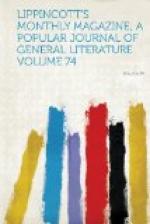[Illustration: New York exhibition building, 1853.]
At the annual exposition of the Olympic games we have the feature of a distribution of prizes. They were conferred, however, only on horses, poets and athletes—a conjunction certainly in advance of the asses and savants that constituted the especial care of the French army in Egypt, but not up to the modern idea of the comprehensiveness of human effort. While our artists confess it almost a vain hope to rival the cameo brooch that fastened the scanty garment of the Argive charioteer, or the statue spattered with the foam of his horses and shrouded in the dust of his furious wheel—while they are content to be teachable, moreover, by the exquisite embroidery and lacework in gold and cotton thread displayed at another semi-religious and similarly ancient reunion at Benares,—they claim the alliance and support of many classes of craftsmen unrepresented on the Ganges or Ilissus. These were, in the old days, ranked with slaves, many of whom were merchants and tradesmen; and they labor yet in some countries under the social ban of courts, no British merchant or cotton-lord, though the master of millions, being presentable at Buckingham Palace, itself the product of the counting-room and the loom. Little, however, does this slight appear to affect the sensibilities of the noble army of producers, who loyally rejoice to elevate their constitutional sovereign on their implements as the Frankish proletaries did upon their shields.
The family of expositions with which we are directly concerned is, like others of plebeian origin, at some loss as to the roots of its ancestral tree. We may venture to locate them in the middle of the eighteenth century. In 1756-57 the London Society of Arts offered prizes for specimens of decorative manufactures, such as tapestry, carpets and porcelain. This was part of the same movement with that which brought into being the Royal Academy, with infinitely less success in the promotion of high art than has attended the development of taste, ingenuity and economy in the wider if less pretentious field.
France’s first exhibition of industry took place in 1798. It was followed by others under the Consulate and Empire in 1801, 1802, 1806. In 1819 the French expositions became regular. Each year attested an advance, and drew more and more the attention of adjacent countries. The international idea had not yet suggested itself. The tendency was rather to the less than the more comprehensive,




